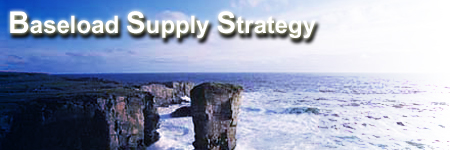


| Environmental Impact |
Introduction Advantages Constraints Technology
Packing density Layout Depth Results References
Introduction
The greatest advantage of Marine Current Turbines is that they emit no greenhouse gas emissions or pollutants. Currently, there has been no Environmental Impact Assessment of MCTs. However, there have been small-scale environmental appraisals of similar technologies such as Stingray [1], initial analyses of the MCT design and assessments of offshore wind farms [2] that can be used to approximate potential environmental impact.
back to top
Advantages
-
MCTs do not emit or produce any greenhouse gases, harmful waste, or pollutants during operation (e.g. CO2, NOx and SOx).
-
Compared to offshore wind farms visual disturbance at sea will be low. The only indication of the presence of MCTs would be the surface piercing structures with navigational-buoyage equipment, and this will be located some distance from the coastline.
-
The low frequency sub-sea noise that would be emitted during operation would not interfere with the echolocation capability of cetaceans and also serve to warn marine mammals to keep away.
-
The minimal effects from installation are only temporal and any sea life displaced would soon return.
-
As fishing and recreational and commercial access within MCT zones would be prohibited, schemes may act as protective man-made reefs in which wildlife may flourish. This could bring serious benefits to endangered species and fragile fish stocks.
Constraints
-
The main visual disturbance would be land-based electrical substations and over-head lines.
-
Public may be concerned with the risk of the turbine rotor colliding with fish or mammals. However this is unlikely because small and medium sized creatures would tend to be pushed out of the way by the blades (due to fluid dynamics) and larger mammals, such as seals, whales and dolphins, are known to avoid ships and ships propellers and could be expected to exhibit that same behaviour with MCTs. Also, a ship's propeller, which is accepted without question for widespread use at sea, is a far greater hazard as it rotates at far greater speeds, e.g. up to 10 times faster, and it is attached to a moving vessel that may travel faster than the fauna.
-
Seismic surveys and blasting prior to installation could create frequency waves that may have negative effects on the health of fish and marine mammals.
-
Construction may disturb the seabed, for example, by the drilling of the piles or the laying of cables, causing destruction of habitat and marine benthos, however this will be relatively small and localised.
-
Installation of cables may also cause sediment displacement, which in turn could cause dangerous particles to be dispersed and contaminate the local environment e.g. radioactive particles discharged from Dounreay. Proposed sites would have to be analysed for contaminants.
-
During operation of the MCT, the pile would experience increased scouring around its base caused by increased turbulence affecting the seabed morphology.
-
Possible discharge of oil from the gearbox or the anti-fouling paint used to prevent bio-fouling may pollute.
-
There are many Sites of Special Scientific Interest (SSSI), which may affect the location of MCT schemes and subsequent cabling.
- Current flow and coastal processes could be affected because an oversized scheme could act as a barrier to the oncoming current. Attempting to extract too much energy from a tidal stream could cause the tide to divert to an easier path.
The second strategy, which selected the maximum number of units that could be installed thus maximising the storage required, would result in maximum environmental impact. The first strategy, which compromised the number of installed units with the aim of reducing the storage required to an acceptable level, would have a less impact.
back to top
Technology
The technology used to secure the turbine to the seabed may also have different impacts. For example, the proposed first-generation of MCTs uses monopiles which could destroy seabed habitats during installation. A second-generation design could use mooring systems, which may have less of an effect on seabed wildlife whilst allowing the turbines to operate in deeper waters.
back to top
Packing density
The density in which units are installed may also influence any environmental effects. For example, drilling monopiles, of a significant distance apart may reduce impact of erosion caused by scouring around the base of the monopile on wildlife. The MCT parametric model and packing density selected in this project, means that across the tidal flow, turbines with diameters of 15.85-metres would be spaced out some 60-metres apart. This would leave a minimum gap of 44 metres from blade tip-to-tip. The turbines would be positioned 1000-metres downstream from each other in order to reduce the negatives effects on performance caused by turbulence and allow for the tidal streams to restore themselves. The horizontal and axial spacing would result a packing density of 18 units per km2, which could allow for tidal stream, the various wildlife and larger mammals to pass through unaffected.
back to top
Layout
The layout of arrays of MCTs could also influence the impact. For example, rows of turbines located besides each other may act as a larger barrier to oncoming tidal stream compared to farms where the turbines are installed in scattered arrays.
back to top
Depth
Waters of depths from 20 to 80 metres chart datum would be used, therefore any wildlife or marine activities using water in depths outside this range would not be directly affected.
back to top
Results
Click on one of the links below to see scenario-specific results:
Minimum Storage (best baseload) Strategy
Maximum Storage (maximum output) Strategy
back to top
References
- Entec UK (2002), Environmental Appraisal of Stingray,Engineering Business.
- MBT Cordah Ltd(2003), Offshore wind energy: phase 1 proposals and environmental report, DTI.